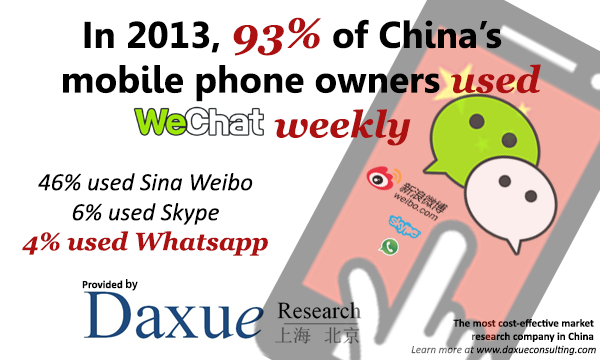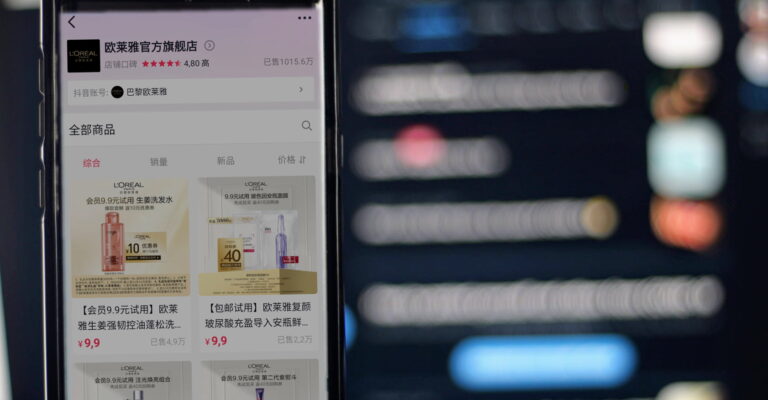How to leverage WeChat in China
What is WeChat—The new king of Chinese social media
WeChat, 3-year-old mobile messaging service social app called Weixin in Chinese, is owned by Chinese tech giant Tencent. It had 272 million active monthly users when the latest figures were released in November last year, and its popularity keeps growing in markets like Brazil, India and Mexico. According to China Internet Watch, “The Total number of monthly active WeChat users reached 396 million, an increase of 12% QoQ or an increase of 87% YoY. The 2014 first quarter results show that WeChat is actively increasing its user base inside and outside of China. Inspired by WhatsApp, it took the concept much further, blending in elements of Facebook and Instagram with a variety of useful and practical functions for users to apply in addition to mobile messaging, such as sending voice messages, sharing social moments, purchasing virtual goods, sending mobile payments and meeting new people.
Now WeChat dominates mobile messaging in China by taking up 82 percent of the market share, which makes mobile messaging services overtake SMS as the largest communication channel among the Chinese. China’s social and mobile landscape is massive, complex and wholly distinct from that of the United States. As China’s population of Internet users grows – the country is expected to have over 800 million Internet users by the end of 2015. – it’s increasingly important for global marketers to understand what makes the opportunity in China unique.

WeChat marketing in China
Apparently, every market player understands how extremely important it is to build a good relationship (“guanxi”) with its current customers and potential customers. An effective social media marketing campaign helps develop a relationship between marketers and its customers by engaging them directly in promoting marketer’s products or services.
It is not a broadcast platform but a 1-1 platform that allows brands and users to create small (less than 100 members) groups. One of the most common but not very effective way brands are using WeChat marketing is by building fan bases and posting content. Brands can send one message per day to their groups and can also create post on their official brand pages. By launching new functionality-“official” accounts, it empowers companies to reach their fans and customer directly. Because WeChat is not mass broadcasting, many brands are looking to create O2O (online to offline) content. Brands are offering special discounts and access to events through their WeChat groups. This strategy is strengthening brands CRM systems and creating strong 1-1 relationships.
Still “How to Maximize WeChat Marketing Campaigns and integrated it into Chinese marketing mix” is the main focus of marketers who intend to take advantage of this huge user base.
Case study of creatively leveraging WeChat to maximize marketing campaigns
The following case studies present a good example as to successfully and creatively leverage the basic functions of WeChat to maximize marketing campaigns.
Montblanc WeChat Marketing Campaign
The well-known luxury brand, Montblanc, has been leading the way with creatively leveraging WeChat. They have recently released a game that fans can play directly in WeChat. The game promotes Montblanc’s interpretation of Daban, which directly translates from Chinese to mean “big boss.”
In this case, the brand is promoting its ideal Daban, meaning a consumer who “behaves in line with the brand’s values of elegance, sophistication and leadership.” This game allows WeChat users to upload pictures of themselves being “The Big Boss” and their friends and other users can vote. The campaign shows the willingness of major brands to integrate WeChat into their marketing mix.
Starbuck’s Three Steps to Optimizing WeChat
Starbucks’s first round of activity took place from 28 August 2012 to 30 September 2012. A user can send an emoticon to Starbucks, who will in return send a track of an album according to the emoticon. By the close of the campaign, Starbucks had tallied 62,000 fans on WeChat and received an average of 22,000 messages per day, with the bulk of the interaction driven by the emoticons.
In its second round of campaigning, Starbucks launched a “morning call” app to promote its newest series of breakfast products. Users can download Starbucks’ app and set the wake-up alarm for 9:00am at the latest – just enough time for breakfast. If users make it into any Starbucks stores within one hour after the alarm setting, then they can enjoy the new breakfast products at half price, along with a purchase of any regular-priced coffee.
The third round of campaign activity, aligned with Chinese New Year, spotlighted a product promotion: the Starbucks Calendar. These daily activities were creative and interactive, including directions like raising a chestnut (in recognition of the new chestnut-flavored coffee) for a free coffee or bear-hugging parents at Starbucks to receive a buy-one-get-one promotion.
Main takeaway points from Starbucks’ WeChat campaign are as follows:
- Service-oriented brands such as food and beverage, hotels, and commercial centers are more suited for using WeChat promotions as O2O (offline-to-offline)
- WeChat’s point-to-point communication ( text, voice, picture, and video) establishes it as a strong customer service platform.
- While new promotion and offers can be sent to followers via WeChat, brands should nonetheless pay attention to the quality of content, push frequency, and time slot to ensure that users stay interested.
WeChat provides another way to build loyalty and promote companies’ wares to Chinese consumers. WeChat messages can be text, images, sound and videos, can be location-relevant and can be sent to groups or singles. Given 38% of Chinese smartphone users, use their mobiles more than five hours a day, checking them every six minutes on average; the audience is well engaged. If executed well, WeChat can be an effective way to communicate with Chinese target market and complimentary to companies’ other marketing.
WeChat’s not just a messaging app, it’s a mobile news reading app, a blogging platform, your new online storefront, a mobile wallet, it’s a resume.
Daxue Consulting Expertise

Our Shanghai-based office
Knowing how to sell on WeChat can make the whole difference between succeeding and failing in China. But all hope is not lost, as there are several ways to correctly leverage WeChat and gain active followers who will promote your brand. To learn more about branding in China, do not hesitate to contact our dedicated project managers by email at dx@daxueconsulting.com.
Follow us on Twitter to learn more about Chinese market:
How innovations in #China will change the world: From Artificial Intelligence to #mpayment https://t.co/Ne76zybkJF pic.twitter.com/ZlvQq7fz7q
— Daxue Consulting (@DaxueConsulting) August 18, 2017






